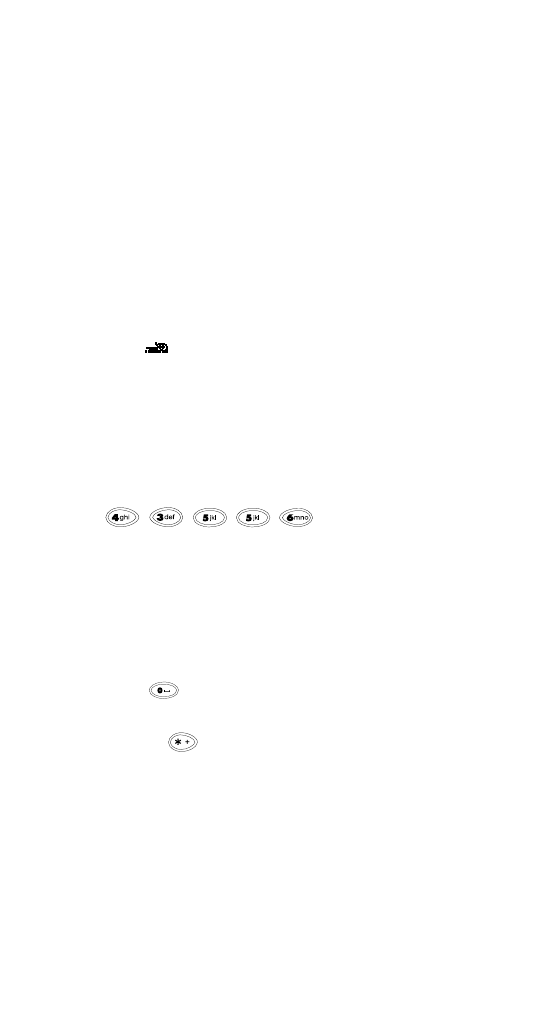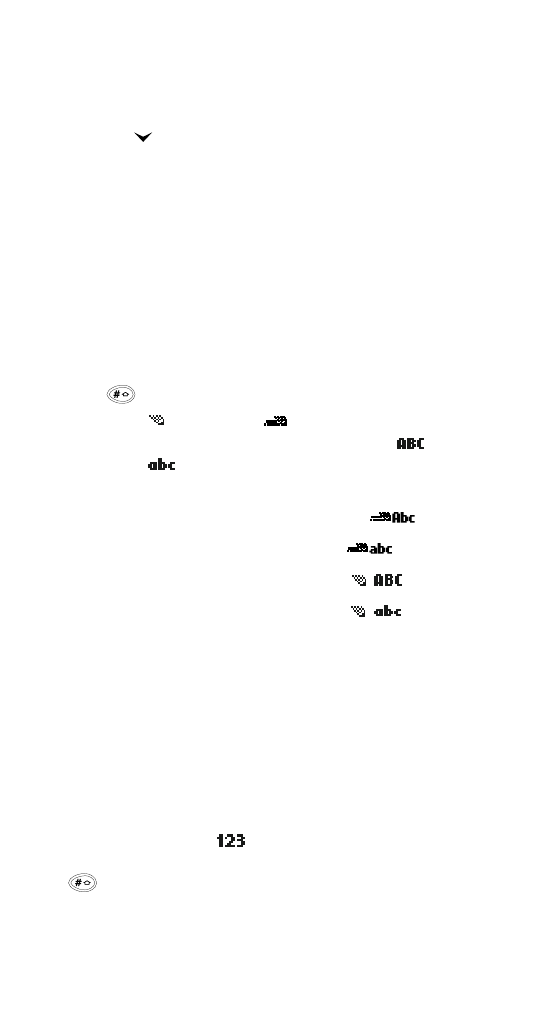
Editing a mobile message
Caution: While editing a message, if you accidentally
press and hold Clear, all text within your message will be
deleted.
A message can contain 88 characters. A counter in the
top right corner of the screen indicates the number of
remaining characters that you can enter. You can use
two different methods to enter text into the message:
• Traditional text input
• Predictive text input
Traditional text input
See “Entering text and numbers” on page 38 for more
information.
Predictive text input
Note: The predictive text feature is based on a built-in
dictionary. Your phone includes several different
language versions of this dictionary. Although your
phone may be able to display a given language on
the screen, it does not necessarily contain a
predictive text dictionary of that same language.
Using the traditional text input method requires that you
press some keys more than once. For example, to enter
the letter “c”, you must press 2 2 2. When using predictive
text input, your phone “guesses” which word you are
typing, requiring that you press a key only once for each
letter you enter.

89
Activating predictive text input
Before you can use the predictive text input method,
you must activate the feature. While editing a message,
press Options, Dictionary, then choose any language.
The predictive text input method is now available for use
when editing.
Changing the language of the dictionary
While editing a message, press Options, Dictionary, then
choose a language.
Writing words
When you begin editing a message, the predictive text
icon (
) appears at the top of the display, indicating
that the phone is in predictive text input mode (the default
mode). If the icon does not appear, predictive text input
has been deactivated. To turn it on, press Options,
Dictionary, then choose the desired input language.
To write a word, press each key only once for each letter
of the word. For example, to write hello, press:
The characters that you enter appear underlined. The word
changes after each keystroke, so try not to pay attention
to how the word appears on the display until you have
pressed all of the keys.
When you finish writing the word, check to ensure that
the word is correct. If the word is correct, enter a space
(press
) and write the next word. If the word is
incorrect and is underlined:
• Press
repeatedly until the desired word appears.
• OR, press Options, Matches. Your phone displays a list
of words. Choose a word from the list, then press Use
or press Back to exit and return to the message editor.
If the ? character appears after the word, there are no
more words in the dictionary that correspond to your key
presses. At this point, you can add the word to the
dictionary by pressing Spell.

90
Writing compound words
To quickly write a compound word (for example, bluejay):
1.
Write the first part (blue).
2.
Press
(do not enter a space). The underline
disappears from the first part.
3.
Write the second part (jay).
Deleting characters
To delete one character to the left of the cursor, press Clear.
To delete all characters in the message, press and hold
Clear.
Changing the method of text input and the case
of letters
Press
repeatedly to change the method of text input
(traditional
or predictive
) and the case of letters
that you enter (sentence case
Abc
Abc
Abc
Abc
, upper case
, or
lower case
). he phone cycles through the following
modes:
• Predictive text input, sentence case:
• Predictive text input, lower case:
• Traditional text input, upper case:
• Traditional text input, lower case:
Tip: If you don’t want to use predictive text input mode
at all, you may want to deactivate it. (You can reactivate
it later.) See ‘Deactivating predictive text input mode’ on
page 91. This will keep you from having to cycle through
all four modes.
Entering numbers
To enter one or just a few numbers, press and hold the
respective number key. To enter many numbers, change to
number entry mode (
) and enter the numbers as
usual. To change to number entry mode, press and hold
, OR, press Options, Insert number.

91
Inserting special characters
To insert a special character (such as a punctuation mark),
press and hold
, OR press Options, Insert symbol.
To quickly insert a period (.), press
. To quickly insert
double dashes (--) or three ellipses (...), press
a few
times.
Adding a word to your personal dictionary
If your phone’s dictionary does not contain a word, you
can add it to your personal dictionary. If the ? character
appears after the word, press Spell. (OR, at any time while
editing, press Options, Insert word.) Enter the word using
traditional text input, and press OK. If your personal
dictionary is full, the new word replaces the oldest added
word.
Deactivating predictive text input mode
To deactivate the predictive text feature, while editing a
message, press Options, Dictionary, Dictionary off.
Templates
Note: Templates are available only in English.
While you’re editing a message, press Options, then
select Add template. Select a template:
1. Call me at [ ]. (phone number/time/place)
2. I’ll call you at [ ]. (time/place)
3. Meet me at [ ]. (time/place)
4. I’ll be there at [ ]. (time)
5. I’ll be [ ] minutes late. (number of minutes)
6. I’m running late.
7. I’m on my way.
8. Meeting cancelled.
9. Meeting changed to [ ]. (time/place)
10. Appointment cancelled.
11. I love you!
12. Thank you!
13. I’m sorry.
14. Call at your convenience.
15. Please call ASAP.

92
Brackets ([ ]) in a template represent a value that you can
specify. (The value is not retained for future use; you enter
the value each time you use the template.) If you select a
template that contains brackets, you’ll be prompted to
enter a value. You can edit the template text after you
insert it into your message.